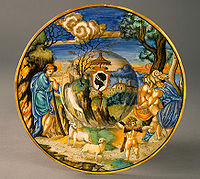
Francesco Xanto Avelli
Encyclopedia

Italy
Italy , officially the Italian Republic languages]] under the European Charter for Regional or Minority Languages. In each of these, Italy's official name is as follows:;;;;;;;;), is a unitary parliamentary republic in South-Central Europe. To the north it borders France, Switzerland, Austria and...
ceramicist. He is best known for his painted maiolica
Maiolica
Maiolica is Italian tin-glazed pottery dating from the Renaissance. It is decorated in bright colours on a white background, frequently depicting historical and legendary scenes.-Name:...
works.
Life
Xanto Avelli was born in RovigoRovigo
Rovigo is a town and comune in the Veneto region of North-Eastern Italy, the capital of the eponymous province. -Geography:...
, in the Veneto
Veneto
Veneto is one of the 20 regions of Italy. Its population is about 5 million, ranking 5th in Italy.Veneto had been for more than a millennium an independent state, the Republic of Venice, until it was eventually annexed by Italy in 1866 after brief Austrian and French rule...
, sometime in the late 1480s. Nothing at all is known of his origins, his teaching, or his early years; he is first recorded as working in Urbino
Urbino
Urbino is a walled city in the Marche region of Italy, south-west of Pesaro, a World Heritage Site notable for a remarkable historical legacy of independent Renaissance culture, especially under the patronage of Federico da Montefeltro, duke of Urbino from 1444 to 1482...
in 1530, when he is mentioned in a notarial
Civil law notary
Civil-law notaries, or Latin notaries, are lawyers of noncontentious private civil law who draft, take, and record legal instruments for private parties, provide legal advice and give attendance in person, and are vested as public officers with the authentication power of the State...
document describing attempts by a group of pottery workers, or interlaboratores artis figuli, to form an early trade union
Trade union
A trade union, trades union or labor union is an organization of workers that have banded together to achieve common goals such as better working conditions. The trade union, through its leadership, bargains with the employer on behalf of union members and negotiates labour contracts with...
for the purpose of raising wage
Wage
A wage is a compensation, usually financial, received by workers in exchange for their labor.Compensation in terms of wages is given to workers and compensation in terms of salary is given to employees...
s. 1530 is also the date on his earliest signed piece, a plate commemorating the coming new year. It is signed .f.X.A.R., and is further marked î Urbino.
At around this time Xanto married a woman called Finalissa, also in Urbino. Over the five years following he produced a large body of work; each piece was signed in various manners, and was dated and marked as a product of Urbino. Such consistency in signing his work was unusual at the time; there is some suggestion that the artist was blacklisted after the labor troubles of 1530, and that his choice to sign his works might be in some way related to his difficulties.
After 1535, Xanto seems to have become less prolific; his works, if signed, are marked in more cursory fashion. He also had a number of associates and followers working with him regularly, basing their style on his. The last documentary record of him comes in 1541, when he is known to have taken on two assistants; that year he also initialed a piece from the workshop of Francesco de Silvano. What later became of him is unknown.
Work
It is not certain whether or not any of Xanto's earlier work has survived, as no unambiguously signed works bearing his signature have been found dating earlier than 1530. General scholarly opinion holds that a number of works dating back to 1524 are also by his hand. No tangible evidence exists suggesting their point of origin, although both FaenzaFaenza
Faenza is an Italian city and comune, in the province of Ravenna, Emilia-Romagna, situated 50 km southeast of Bologna.Faenza is noted for its manufacture of majolica ware glazed earthenware pottery, known from the name of the town as "faience"....
and Urbino have been proposed by historians.
Xanto's signed works all date from between 1530 and 1542. Each bears his name and the date of the piece; many also were given ambitious tags explaining their meanings. The surviving pieces appear to be similar in nature, with the exception of the signatures, to most other maiolica ware produced in Urbino at the time. Xanto signed his works with a number of different variants of his own name; besides those with his full name, pieces signed fra Xanto in his hand are known to exist.
Besides being a ceramicist, Xanto was also a poet; in the 1530s he wrote a sequence of sonnet
Sonnet
A sonnet is one of several forms of poetry that originate in Europe, mainly Provence and Italy. A sonnet commonly has 14 lines. The term "sonnet" derives from the Occitan word sonet and the Italian word sonetto, both meaning "little song" or "little sound"...
s in praise of Francesco Maria I della Rovere
Francesco Maria I della Rovere
Francesco Maria I della Rovere was an Italian condottiero, who was Duke of Urbino from 1508 until 1538.- Biography :...
, then duke of Urbino. An elegant fair copy survives in the Vatican Library
Vatican Library
The Vatican Library is the library of the Holy See, currently located in Vatican City. It is one of the oldest libraries in the world and contains one of the most significant collections of historical texts. Formally established in 1475, though in fact much older, it has 75,000 codices from...
.

